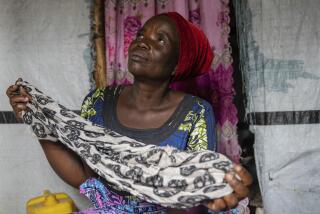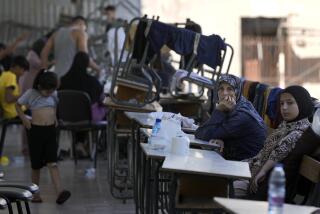Next Step : The U.N....
SITE 2, Thailand â San Doun is a 29-year-old Cambodian peasant who cannot recall her native land. For the last 12 years, she has lived in a refugee camp along the Thai border. But now she wants to go home.
âWe left a long time ago, and I donât remember anything about Cambodia,â she said in an interview outside her bamboo hut here in the Site 2 refugee camp. âWe really want to go back, but we are very worried about the security. We want the United Nations to protect us.â
For the roughly 360,000 Cambodian refugees who live in U.N. camps along the Thai side of the border, these are momentous, anguished times. The refugees have been eagerly preparing to return since last October, when a comprehensive, international peace agreement signed in Paris brought an official end to a generation of warfare in their country. Nevertheless, few have any clear idea what fate awaits them.
There are concerns, for example, about the armed bandits who have been increasingly terrorizing Cambodia since last yearâs cease-fire ended most of the fighting between the Vietnamese-backed government in Phnom Penh and three anti-government guerrilla groups. Others worry about the millions of land mines left behind by all the years of fighting--mines that have given Cambodia, with 35,000 legless people, the dubious distinction of being the country with the worldâs highest per capita population of disabled.
Many are also uncertain what kind of reception they may receive from fellow Cambodians who stayed home during the years of conflict and who presume that the refugees are loyal to one or another of the guerrilla factions.
The Office of the U.N. High Commissioner for Refugees, which has taken the lead in the repatriation process, has tried to allay some of the refugeesâ fears by promising them that they will be protected by thousands of U.N. peacekeeping troops expected to be deployed in Cambodia to implement the Paris peace agreement. The United Nations is to administer the country until general elections can be held in 1993, and it is anxious to repatriate the refugees before then.
But âweâre worried that the repatriation will be too hasty,â said Pierre Josseron, head of the International Committee of the Red Cross office in nearby Aranyaprathet. âWe hope the UNHCR will resist all the pressures to move before everything is ready.â
Each of the half-dozen largest refugee camps, while funded by the U.N. Border Relief Organization, is administered by a different guerrilla faction and policed by the Thai military and a special border police unit. While the United Nations or the Thai police might take control at any given time, the nature of the camps is such that the guerrillas have virtually a free hand over the refugees because of a potent combination of group loyalty and fear.
Three of the camps are controlled by the hard-line Khmer Rouge, ostensibly reformed from the movement that, in the late 1970s, ruled Cambodia under a reign of genocidal terror that left an estimated 1 million dead of starvation, torture and execution. That government, under dictator Pol Pot, fell to invading Vietnamese forces in early 1979--the year most of the refugees crossed the border into Thailand.
Two other camps are run by the conservative Khmer Peopleâs National Liberation Front, and one is administered by followers of a former monarch, Prince Norodom Sihanouk, who has presided over Cambodiaâs transitional authority since he returned to Phnom Penh late last year.
The U.N. refugee agency and Thai refugee officials are hoping to begin the repatriation process later this month or early in April, moving 10,000 people a week back to their homeland with the goal of finishing the process by the end of the year.
Work has been completed on four âstaging areasâ in Thailand, where the refugees will board buses chartered by the U.N. agency for the drive across the border to six reception centers in Cambodia. The Thai army is now clearing mines from a 30-mile stretch of road from the border to the city of Sisophon in western Cambodia for the refugee convoys.
One part of the repatriation plan has already generated much bewilderment and controversy. The United Nations promised every refugee family a plot of two hectares, or roughly five acres, of farmland in the province of their choice.
But nearly 75% of the refugees indicated during registration that they want to be resettled in just two border provinces, Battambang and Banteay Meanchey, and it is now apparent that there wonât be enough land available in those regions for the United Nations to make good its promise.
As a result, the refugee agency has been forced to offer refugees two alternatives: to accept a small hut in the village of their choice until land can be found, or assistance--yet to be defined--to enable people to set up âincome-generatingâ businesses such as bicycle repair shops.
But the Cambodian peasants who make up the bulk of the camp populations are overwhelmingly rural and are anxious to return to the farm. The result: While six months ago, 90% of families said they would only go with the United Nations, hundreds are now turning to guerrilla groups to provide land for them. International aid groups had been fervently hoping that refugees would stay under U.N. auspices, but the choice is ultimately up to the people themselves.
The guerrilla groups are anxious to have the returning refugees resettle in areas they control inside Cambodia rather than risk having them take shelter in regions where they might fall under the political influence of rival factions.
Last fall, an international outcry was raised when it appeared that the Khmer Rouge was going to force the thousands of refugees living in Khmer Rouge-run camps onto Cambodian territory it controls near the Thai border. The land was under the direction of a commander known as Nikorn, who was reputedly linked directly to the hated Pol Pot leadership.
While the forced-resettlement plans apparently have been dropped, hundreds of refugees have been taken since January on âescorted toursâ of Khmer Rouge areas near the Mongkol Borei River.
Kim Ee, a senior official in charge of health matters at the Khmer Rouge-controlled Site 8 refugee camp, said in an interview that 1,600 families subsequently asked to be transferred to Cambodian farms in the areas held by the movementâs guerrillas.
As Kim Ee noted, the group was offering immediate resettlement on land that has plenty of water and in some cases was even working farmland before the war. But the land now also contains land mines and a high concentration of malaria-carrying mosquitoes.
While Kim Ee insisted that no coercion was used on the families who chose the Khmer Rouge land, one refugee official remarked that for most refugees the âgun is in the head,â meaning that overt intimidation was not necessary to peasants so long exposed to the terror tactics of the Khmer Rouge.
In an earlier U.N. survey at the Site 8 camp, 95% of the people asked to be taken to an area away from Khmer Rouge control.
Apart from the shortage of land, officials are concerned about how refugees will adjust to their homeland after being away for so long. Nearly half the camp population is under 15 years old--and never worked in a rice paddy or knew the rigors of life in rural Cambodia.
The refugee camps are like bamboo-and-thatch cities, with broad rutted avenues and the foul stench of open sewers. There are schools and medical clinics--even clinics for the refugeesâ pets as well as such amenities as clean drinking water, fire stations and childrenâs libraries provided by Americaâs Moral Rearmament Movement.
Life in the camps is extremely comfortable by world refugee standards--U.N. food supplies long ago wiped out any traces of hunger. But only a minority in the camps have any farming skills. Classes have been conducted on how to grow rice and raise animals, but such sessions are considered a poor substitute for the real thing.
Compounding the problem, many of those in the camps are relatives of guerrilla fighters who are soon to be demobilized in Cambodia, thus losing their incomes--however meager they were.
How will the refugees fare in the countryside of Cambodia, where malaria is rife and water-borne diseases are extremely common?
âWeâre looking to the United Nations to keep providing us with food and medicine,â said Kin Hai, a 56-year-old villager who now lives in Site 2.
The United Nations is planning to provide food assistance for 12 to 18 months after resettlement, and joint projects with other U.N. agencies will be aimed at setting up such things as wells for clean drinking water.
âThey will have to make an adjustment,â said Jahanshah Assadi, the U.N. agencyâs repatriation coordinator in Aranyaprathet. âItâs not a humanitarian repatriation. Itâs a political repatriation,â said another refugee aid worker, who asked not to be identified. âIf this was a humanitarian repatriation, they would take more time to clear the mines and prepare the infrastructure to receive the refugees. Right now, only about 10% of the needed land is available.â
The biggest concern in the camps, however, remains the security situation at home, where there have been reports of sporadic battles despite the cease-fire.
Under the Cambodian peace agreement, the four factions are to be disarmed under U.N. supervision, with 70% of the combatants to be demobilized and the remainder kept in special zones.
But the U.N. peacekeeping force, called the U.N. Transitional Authority in Cambodia, is not likely to be fully deployed until May or June.
Some refugee aid officials have expressed deep concerns about repatriating refugees with the peace force not yet fully functional and the factions not yet disarmed.
âThey face a great dilemma,â said a high-ranking U.N. official who asked not to be named. âIf someone gets blown up, that will certainly halt the repatriation in its tracks. Land is not the issue. Protection is the real issue now.â
More to Read
Sign up for Essential California
The most important California stories and recommendations in your inbox every morning.
You may occasionally receive promotional content from the Los Angeles Times.










